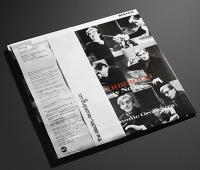Electric Recording Company Unleashes Mighty Mahler's 9th Symphony
Some consider this is great, essential rendering while others call it "second rate", "lacking in conviction, and bettered by just about every other recording from Bernstein to Walter to Pee Wee Herman. No, Pee Wee didn't conduct this piece, but had he, that particular reviewer probably would have said it was better than this one by John Barbirolli conducting the Berlin Philharmonic.
Classical music aficionados I know are big fans of both the conductor and this performance. One told me that only a passionate man like Barbirolli could properly express Mahler's intentions, and that's what the reviewers say who are big fans of this recording. "His best Mahler" one writes.
And clearly the vinyl buying public is equally enthusiastic because used copies of this superb stereo recording, when you can find one, are relatively expensive, which is one indicator The Electric Recording Company uses to choose what to release on vinyl cut from original master tapes on its fully restored valve (tube) cutting system.
In 1963 Barbirolli conducted the Berlin Philharmonic at home in a performance of this symphony that so moved members of the orchestra (which supposedly at that point was not particularly Mahler-friendly) that it requested a recording, even though the Berlin was signed to DGG. In fact the orchestra members were unanimous in requesting the recording and as subsequent live performances demonstrated, so was the German public.
A deal was struck and a year after the original performance the orchestra was permitted to record this symphony with Barbirolli with EMI engineers at the board (or desk as they call it in the UK). The resulting sonics are unlike anything heard from DGG back then.
While many love to soak in the distant, reverberant and elegant DGG sound, this recording, produced January, 1964 in the Jesus-Christuskirche, a modern venue in the suburb of Dahlem in five three hour sessions has an intimate, yet spacious and rich mid-to-front of hall balance.
It's funny reading the CD reviews that claim the latest CD reissue is smooth and warm compared to the original CD, which was less than inviting. That's now, but back then the first CD was probably declared a "sonic revelation" compared to the "old vinyl" version. That's how it was back them.
I've not heard an original but this one is sonically magnificent tonally and spatially. The strings, brass and woodwinds are vividly rendered in three-dimensions. The second movement's horns are particular rich and well- burnished and the fourth movement, which is all about lush strings, are swoon-inducing. Mahler died before he could hear this symphony performed.
The Electric Recording Company maintains its packaging perfection, spreading the work over three sides, with each record getting the full ERC treatment: that means fold over covers, "old school" printing and all of ERC's accoutrements. Most importantly, Record Industry's flat profile pressings are now fully realized.
While the earlier ERC releases were very good, these two records were physically and sonically perfect. The set is limited to 300 copies and it's costly. You can buy the records separately to spread the financial pain. The first LP in the set costs approximately $450, while the single-sided second LP costs around $390.
Expensive? Yes. Outrageous? Perhaps, but originals are hard to come by. I found only two copies on Popsike, one selling in 2005 for $106 and the other selling for $405 in 2004.
There's a copy on Ebay right now (2/25/15), auction ending around 7PM. Good luck! Otherwise there's this pricey, but pristine reissue, sure to also become a collector's item.
The sound is rich, transparent and everything it's claimed to be by those extolling its sonic and musical virtues. You will never hear 1950s-60's era Berlin Philharmonic so intimately and lovingly recorded in a performance the orchestra insisted upon documenting to vinyl.


